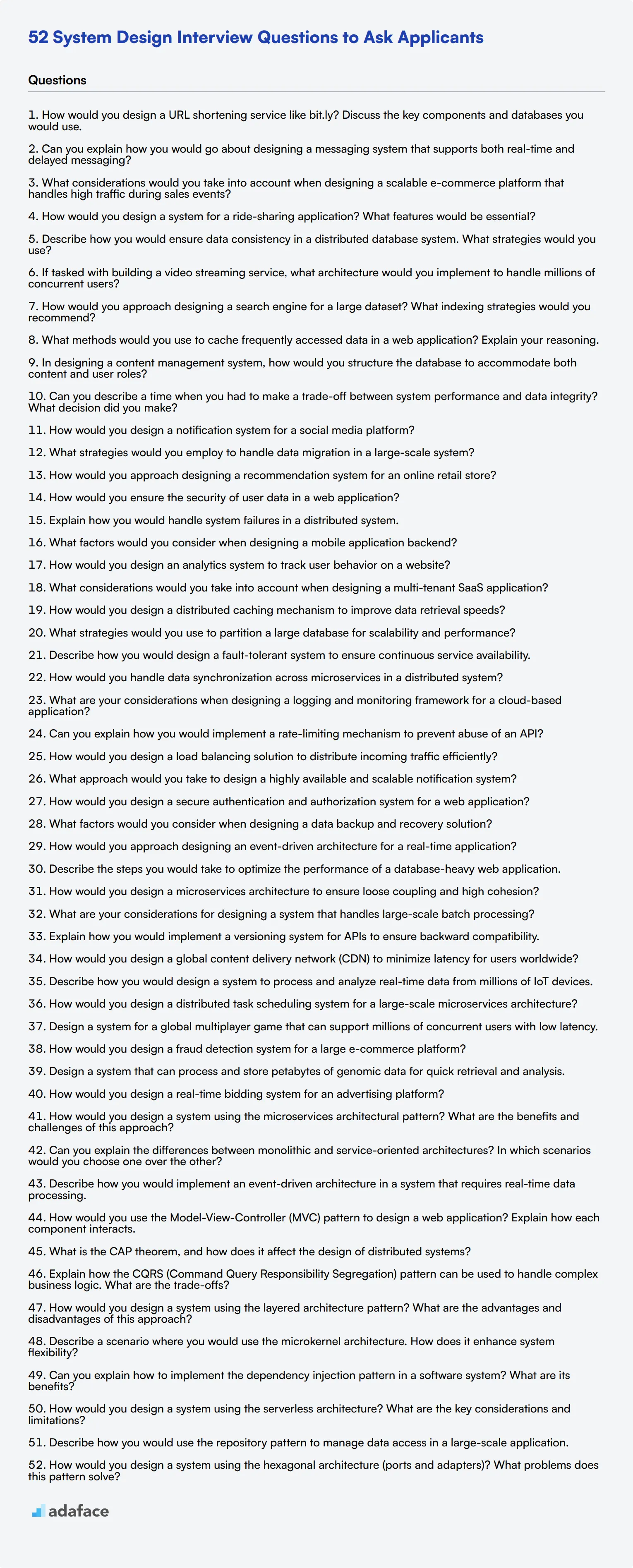As a hiring manager or recruiter, selecting the right system design interview questions can be the difference between finding a stellar candidate or missing out on potential talent. Understanding how to frame these questions not only speeds up the hiring process but also ensures that candidates meet the necessary technical and architectural requirements of your company.
This blog post covers various system design interview questions to ask at different levels, from junior designers to senior designers. You will find categories such as common questions, intermediate, and advanced questions, as well as questions specifically related to architectural patterns.
Leveraging these questions will streamline your interview process and help you identify candidates who truly understand system design. To further enhance your assessment, consider using our Software System Design online test beforehand to identify suitable candidates.
Table of contents
10 common System Design interview questions to ask your applicants
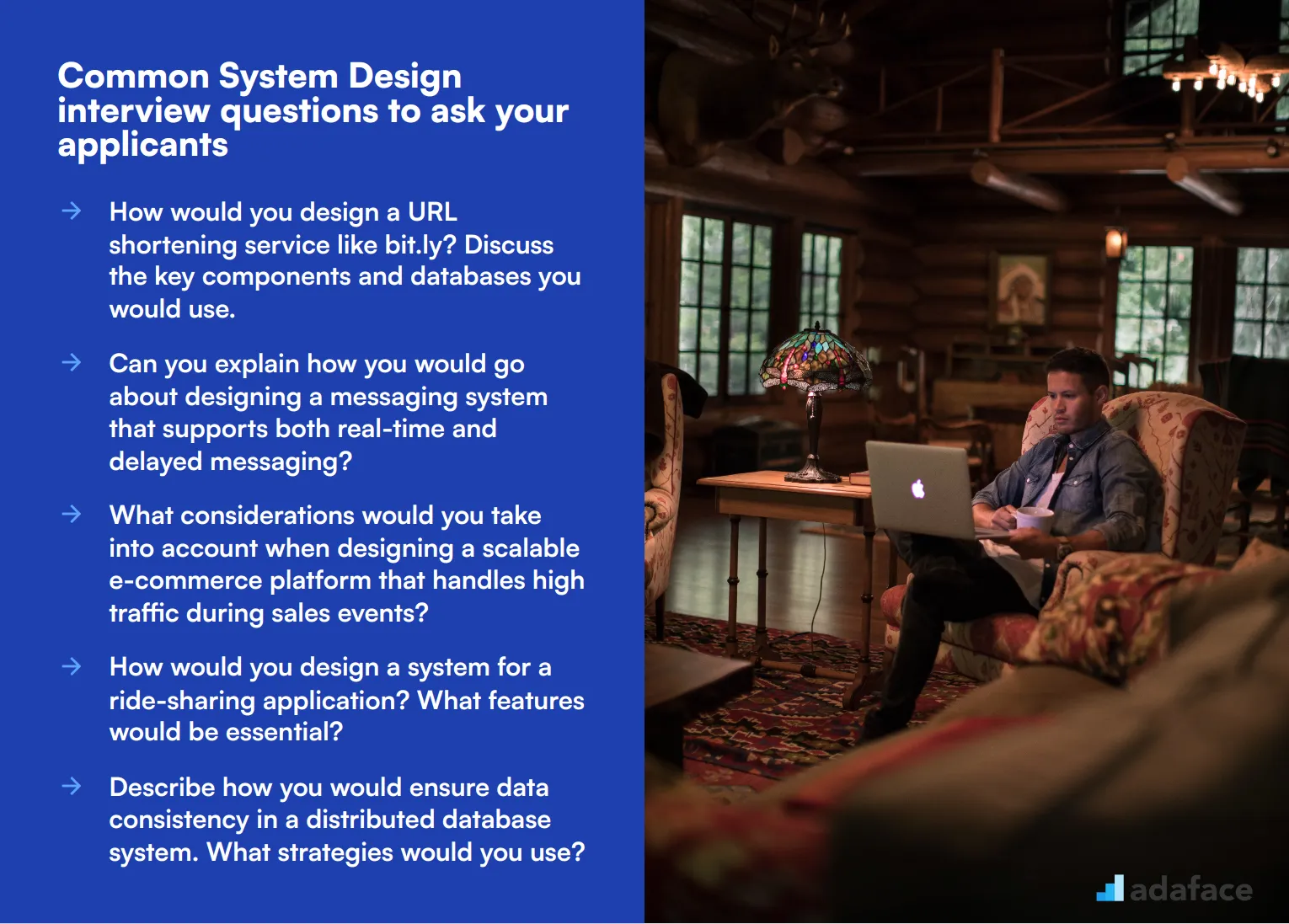
To effectively evaluate a candidate's system design abilities, it's crucial to ask targeted questions that reveal their understanding of complex architectures. Use this list of questions during interviews to gain insights into how well applicants can tackle real-world challenges and design scalable systems. For a comprehensive job description, you might also refer to our software architect job description.
- How would you design a URL shortening service like bit.ly? Discuss the key components and databases you would use.
- Can you explain how you would go about designing a messaging system that supports both real-time and delayed messaging?
- What considerations would you take into account when designing a scalable e-commerce platform that handles high traffic during sales events?
- How would you design a system for a ride-sharing application? What features would be essential?
- Describe how you would ensure data consistency in a distributed database system. What strategies would you use?
- If tasked with building a video streaming service, what architecture would you implement to handle millions of concurrent users?
- How would you approach designing a search engine for a large dataset? What indexing strategies would you recommend?
- What methods would you use to cache frequently accessed data in a web application? Explain your reasoning.
- In designing a content management system, how would you structure the database to accommodate both content and user roles?
- Can you describe a time when you had to make a trade-off between system performance and data integrity? What decision did you make?
8 System Design interview questions and answers to evaluate junior designers
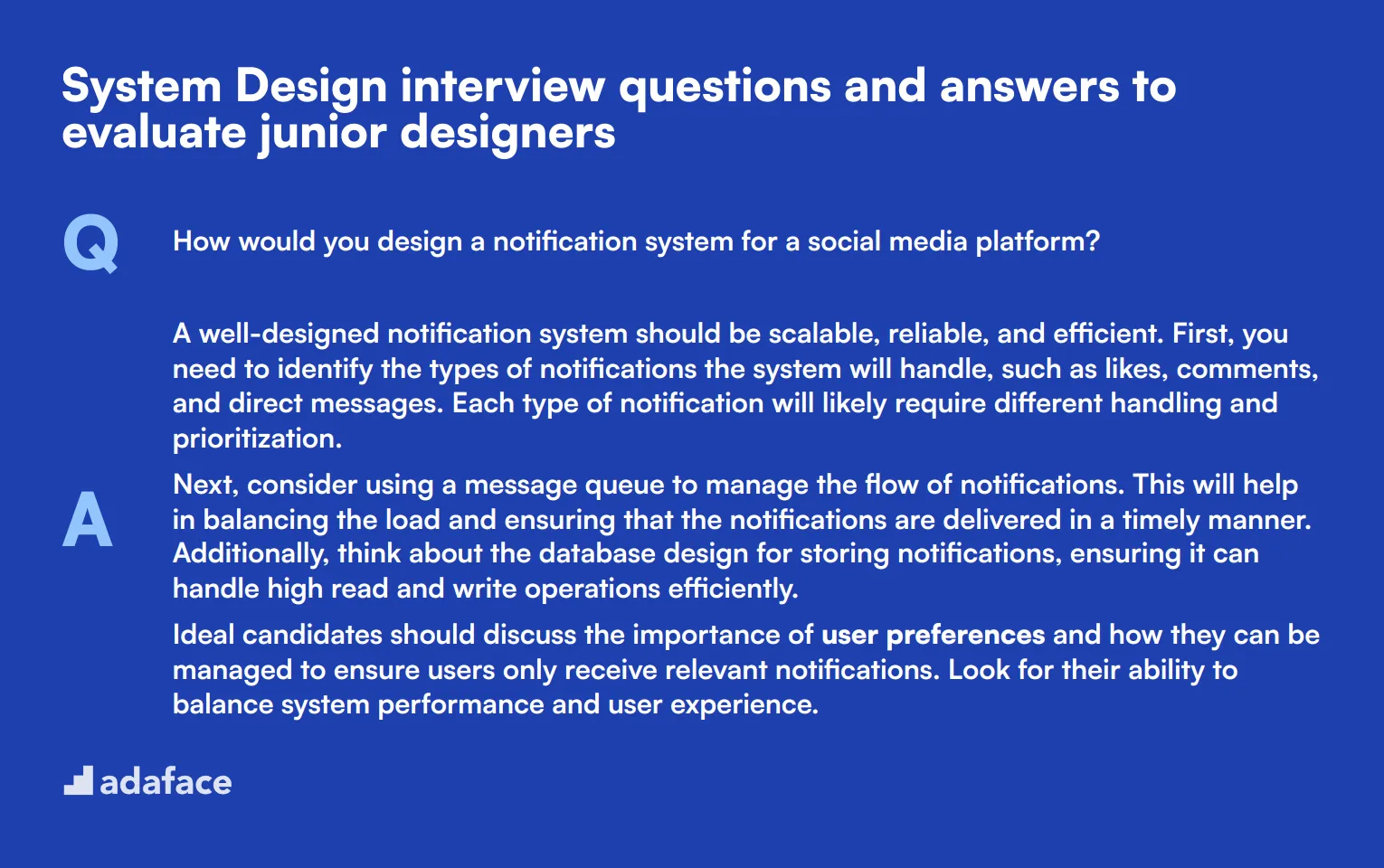
To assess whether your junior designers have a solid foundation in system design, use these questions to gauge their understanding of key concepts and practical application. This list will help you identify candidates who can think critically and solve complex problems, even if they are still early in their careers.
1. How would you design a notification system for a social media platform?
A well-designed notification system should be scalable, reliable, and efficient. First, you need to identify the types of notifications the system will handle, such as likes, comments, and direct messages. Each type of notification will likely require different handling and prioritization.
Next, consider using a message queue to manage the flow of notifications. This will help in balancing the load and ensuring that the notifications are delivered in a timely manner. Additionally, think about the database design for storing notifications, ensuring it can handle high read and write operations efficiently.
Ideal candidates should discuss the importance of user preferences and how they can be managed to ensure users only receive relevant notifications. Look for their ability to balance system performance and user experience.
2. What strategies would you employ to handle data migration in a large-scale system?
Data migration in a large-scale system requires careful planning and execution. One strategy is to use a phased approach, where data is migrated in chunks rather than all at once. This minimizes downtime and reduces the risk of data loss or corruption.
Another strategy is to use a dual-write system, where both the old and new systems receive updates during the migration period. This ensures data consistency and allows for a smooth transition.
Candidates should highlight the importance of testing and validating the migrated data to ensure accuracy. They should also mention having a rollback plan in case something goes wrong during the migration process.
3. How would you approach designing a recommendation system for an online retail store?
Designing a recommendation system involves understanding user behavior and preferences. One approach is to use collaborative filtering, which makes recommendations based on the preferences of similar users. Another approach is content-based filtering, which recommends items similar to those the user has shown interest in.
A hybrid approach combining both collaborative and content-based filtering can offer more accurate recommendations. The system should also be able to handle large volumes of data and provide real-time recommendations.
Strong responses should emphasize the importance of data collection and preprocessing. Candidates should also discuss scalability and how they would handle increasing data volumes and user interactions.
4. How would you ensure the security of user data in a web application?
Ensuring user data security starts with encryption, both at rest and in transit. Use HTTPS to secure data transmitted over the internet and encrypt sensitive data stored in the database.
Implement strong authentication and authorization mechanisms to control access to user data. Regularly update and patch the system to protect against known vulnerabilities.
Candidates should also mention the importance of monitoring and logging to detect and respond to security incidents. Look for a comprehensive approach that covers multiple layers of security.
5. Explain how you would handle system failures in a distributed system.
Handling system failures in a distributed system involves designing for fault tolerance. One approach is to use redundancy, where critical components are duplicated to ensure availability even if one component fails.
Implementing a monitoring and alerting system helps in quickly identifying and responding to failures. Using techniques like load balancing and failover can also help in managing system failures.
Ideal candidates should discuss resilience strategies and how they would design the system to recover gracefully from failures. Look for their understanding of the trade-offs involved in achieving high availability and reliability.
6. What factors would you consider when designing a mobile application backend?
When designing a mobile application backend, consider factors like performance, scalability, and security. The backend should be able to handle varying loads and provide quick response times to ensure a good user experience.
Data synchronization is another important factor, especially for offline capabilities. Ensure that the backend can efficiently sync data between the mobile device and the server.
Candidates should also discuss API design and how they would make the backend APIs efficient and easy to use. Look for their ability to balance performance with other considerations like security and maintainability.
7. How would you design an analytics system to track user behavior on a website?
Designing an analytics system involves collecting, storing, and processing large volumes of data. The first step is to define the key metrics you want to track, such as page views, click-through rates, and user sessions.
Use a scalable data storage solution to handle the large volume of data. Implement real-time data processing to provide up-to-date analytics. Visualization tools can help in making the data easily understandable.
Strong candidates should discuss data accuracy and how they would ensure the data collected is reliable. They should also talk about the importance of user privacy and compliance with regulations like GDPR.
8. What considerations would you take into account when designing a multi-tenant SaaS application?
Designing a multi-tenant SaaS application involves ensuring data isolation and security for each tenant. One approach is to use a single database with tenant-specific tables or schemas. Another approach is to use separate databases for each tenant.
Scalability is another important consideration. The system should be able to handle an increasing number of tenants without performance degradation. Implementing a robust access control mechanism is also crucial.
Candidates should highlight the importance of customizability and how they would allow each tenant to customize the application to meet their specific needs. Look for their ability to balance the needs of multiple tenants while maintaining system performance and security.
15 intermediate System Design interview questions and answers to ask mid-tier designers.
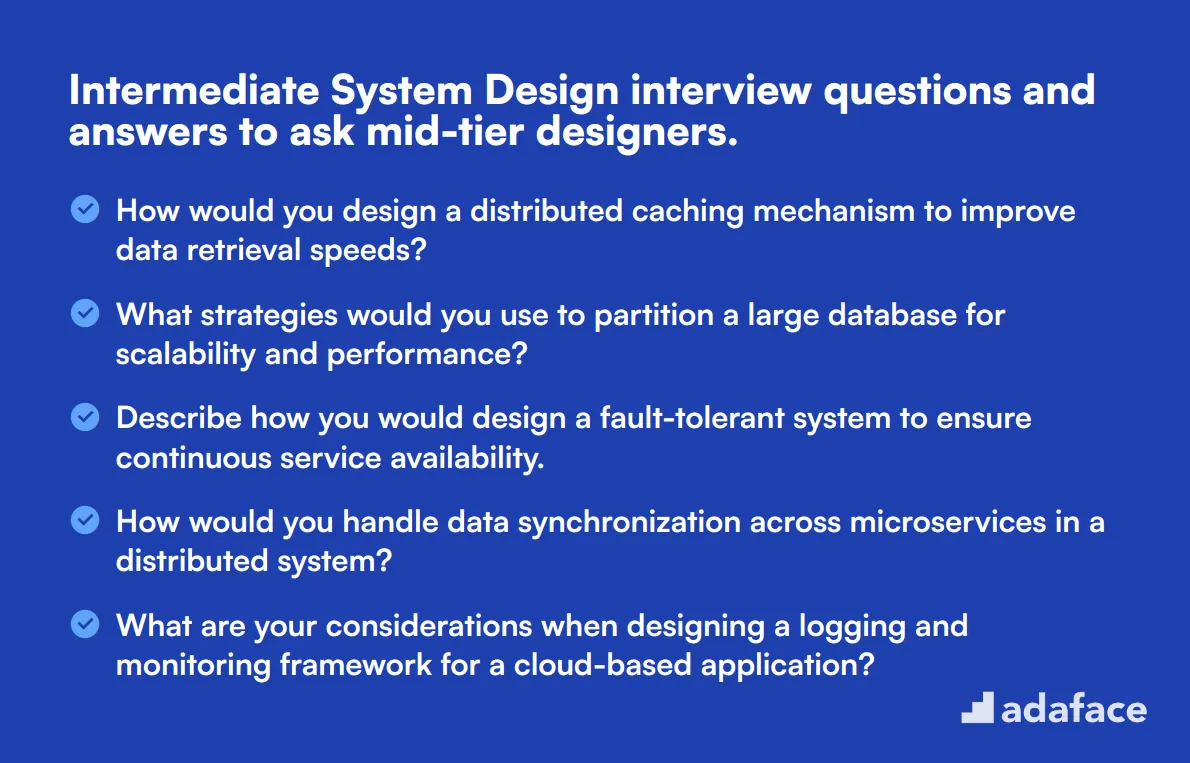
To help you identify mid-tier designers with strong system design skills, we've compiled a list of intermediate interview questions. Whether you're hiring for a software architect or another key role, these questions will help you assess the candidate's ability to tackle complex system design challenges effectively.
- How would you design a distributed caching mechanism to improve data retrieval speeds?
- What strategies would you use to partition a large database for scalability and performance?
- Describe how you would design a fault-tolerant system to ensure continuous service availability.
- How would you handle data synchronization across microservices in a distributed system?
- What are your considerations when designing a logging and monitoring framework for a cloud-based application?
- Can you explain how you would implement a rate-limiting mechanism to prevent abuse of an API?
- How would you design a load balancing solution to distribute incoming traffic efficiently?
- What approach would you take to design a highly available and scalable notification system?
- How would you design a secure authentication and authorization system for a web application?
- What factors would you consider when designing a data backup and recovery solution?
- How would you approach designing an event-driven architecture for a real-time application?
- Describe the steps you would take to optimize the performance of a database-heavy web application.
- How would you design a microservices architecture to ensure loose coupling and high cohesion?
- What are your considerations for designing a system that handles large-scale batch processing?
- Explain how you would implement a versioning system for APIs to ensure backward compatibility.
7 advanced System Design interview questions and answers to evaluate senior designers
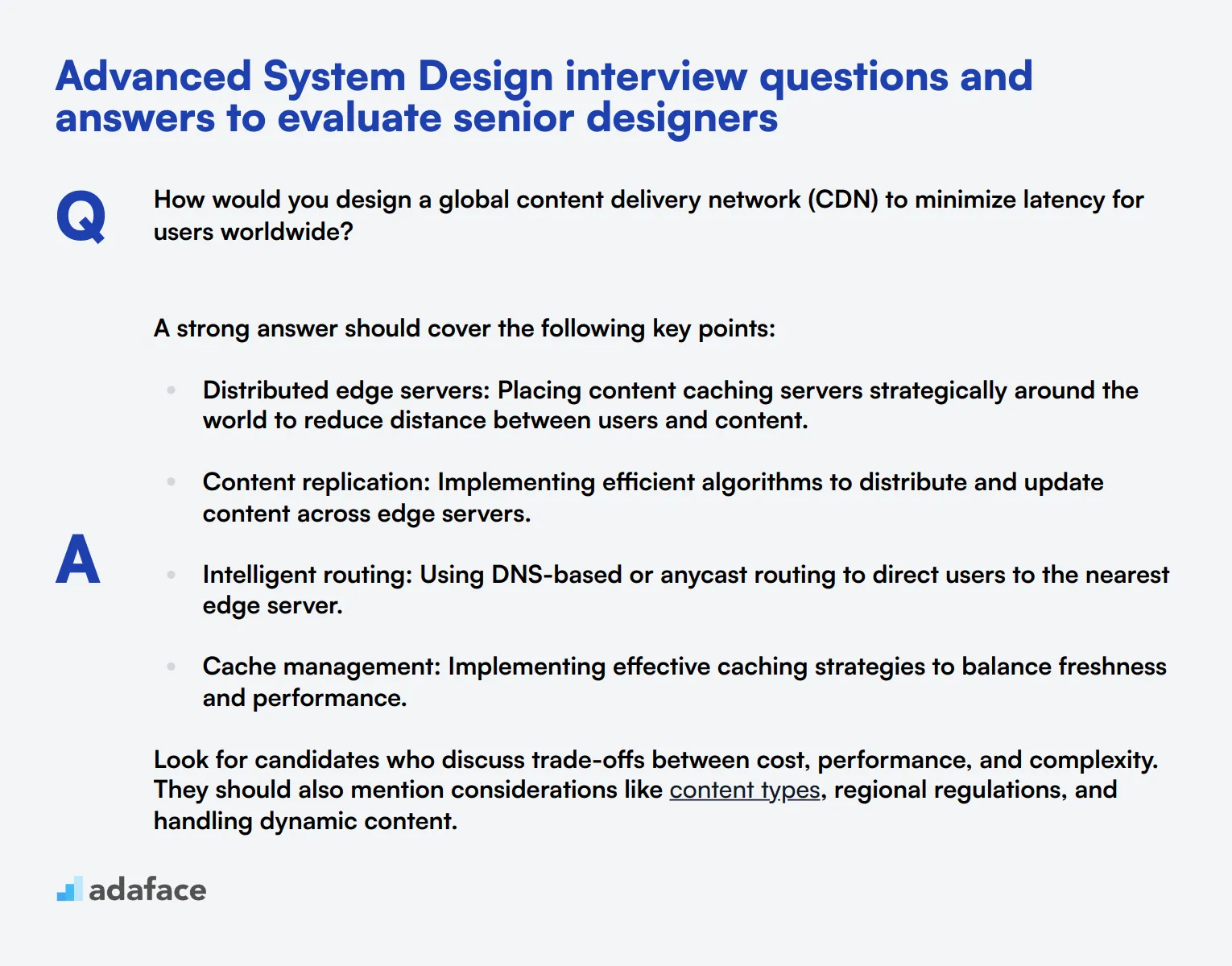
Ready to put your senior designers through their paces? These seven advanced System Design interview questions will help you evaluate candidates' ability to tackle complex architectural challenges. Use them to assess how candidates approach scalability, performance, and reliability in real-world scenarios. Remember, the devil's in the details, so listen closely to their reasoning!
1. How would you design a global content delivery network (CDN) to minimize latency for users worldwide?
A strong answer should cover the following key points:
- Distributed edge servers: Placing content caching servers strategically around the world to reduce distance between users and content.
- Content replication: Implementing efficient algorithms to distribute and update content across edge servers.
- Intelligent routing: Using DNS-based or anycast routing to direct users to the nearest edge server.
- Cache management: Implementing effective caching strategies to balance freshness and performance.
Look for candidates who discuss trade-offs between cost, performance, and complexity. They should also mention considerations like content types, regional regulations, and handling dynamic content.
2. Describe how you would design a system to process and analyze real-time data from millions of IoT devices.
An ideal response should include these components:
- Data ingestion: Using a distributed message queue (e.g., Kafka, AWS Kinesis) to handle high-volume data streams.
- Stream processing: Implementing a real-time processing framework (e.g., Apache Flink, Spark Streaming) for immediate analysis.
- Storage: Utilizing a combination of hot storage for recent data and cold storage for historical data.
- Analytics: Incorporating both real-time dashboards and batch processing for deeper insights.
Evaluate candidates on their ability to address scalability, fault tolerance, and data consistency. Look for mentions of edge computing to reduce latency and bandwidth usage, and strategies for handling device heterogeneity and unreliable connections.
3. How would you design a distributed task scheduling system for a large-scale microservices architecture?
A comprehensive answer should cover:
- Task queue: Implementing a distributed queue system (e.g., RabbitMQ, Apache Pulsar) to manage tasks.
- Worker nodes: Designing a scalable pool of worker services to execute tasks.
- Scheduling algorithm: Developing a fair and efficient method for task distribution, considering priorities and dependencies.
- State management: Ensuring task progress and results are reliably stored and retrievable.
- Monitoring and retry mechanisms: Implementing robust error handling and task recovery processes.
Look for candidates who discuss strategies for handling task idempotency, dealing with long-running tasks, and ensuring system reliability. They should also consider how to integrate the scheduler with existing microservices and handle inter-service communication.
4. Design a system for a global multiplayer game that can support millions of concurrent users with low latency.
Key elements of a strong response include:
- Distributed server architecture: Using regional game servers to minimize latency for players.
- Matchmaking system: Implementing an efficient algorithm to group players based on skill level and ping.
- State synchronization: Designing a system to keep game state consistent across clients and servers.
- Scalable backend: Utilizing cloud services for automatic scaling during peak times.
- Anti-cheat measures: Implementing server-side validation and encryption to prevent cheating.
Evaluate candidates on their approach to handling network issues, server selection for optimal performance, and strategies for reducing bandwidth usage. Look for discussion on how to balance between client-side prediction and server authority to provide a smooth yet fair gameplay experience.
5. How would you design a fraud detection system for a large e-commerce platform?
A comprehensive answer should include:
- Real-time analysis: Implementing stream processing to analyze transactions as they occur.
- Machine learning models: Utilizing algorithms to detect anomalies and patterns indicative of fraud.
- Rule-based systems: Incorporating configurable rules to flag suspicious activities.
- Data enrichment: Integrating external data sources to enhance fraud detection capabilities.
- Feedback loop: Designing a system to continuously improve detection accuracy based on confirmed fraud cases.
Look for candidates who discuss the balance between false positives and false negatives, and how to handle the ever-evolving nature of fraud tactics. They should also consider privacy concerns, regulatory compliance, and the need for explainable AI in fraud detection decisions.
6. Design a system that can process and store petabytes of genomic data for quick retrieval and analysis.
An effective answer should cover:
- Distributed storage: Using systems like HDFS or object storage for handling large volumes of data.
- Indexing strategies: Implementing efficient indexing methods for quick data retrieval.
- Parallel processing: Utilizing frameworks like Apache Spark for distributed data analysis.
- Data compression: Applying domain-specific compression algorithms to reduce storage requirements.
- Access control: Implementing robust security measures to protect sensitive genetic information.
Evaluate candidates on their understanding of big data technologies and their ability to design for both batch and interactive query processing. Look for discussion on how to handle data versioning, maintain data lineage, and scale the system as the volume of genomic data grows exponentially.
7. How would you design a real-time bidding system for an advertising platform?
A strong response should include the following components:
- High-performance bid processing: Designing a system to handle millions of bid requests per second with low latency.
- User profiling: Implementing a system to maintain up-to-date user profiles for targeted advertising.
- Advertiser management: Creating interfaces for advertisers to set budgets, bids, and targeting criteria.
- Auction mechanism: Developing an efficient algorithm to determine winning bids in real-time.
- Reporting and analytics: Building systems to provide real-time performance metrics to advertisers.
Look for candidates who discuss strategies for handling peak loads, ensuring fairness in the bidding process, and maintaining system reliability. They should also consider how to optimize for both advertiser ROI and user experience, and address privacy concerns in user targeting.
12 System Design interview questions about architectural patterns
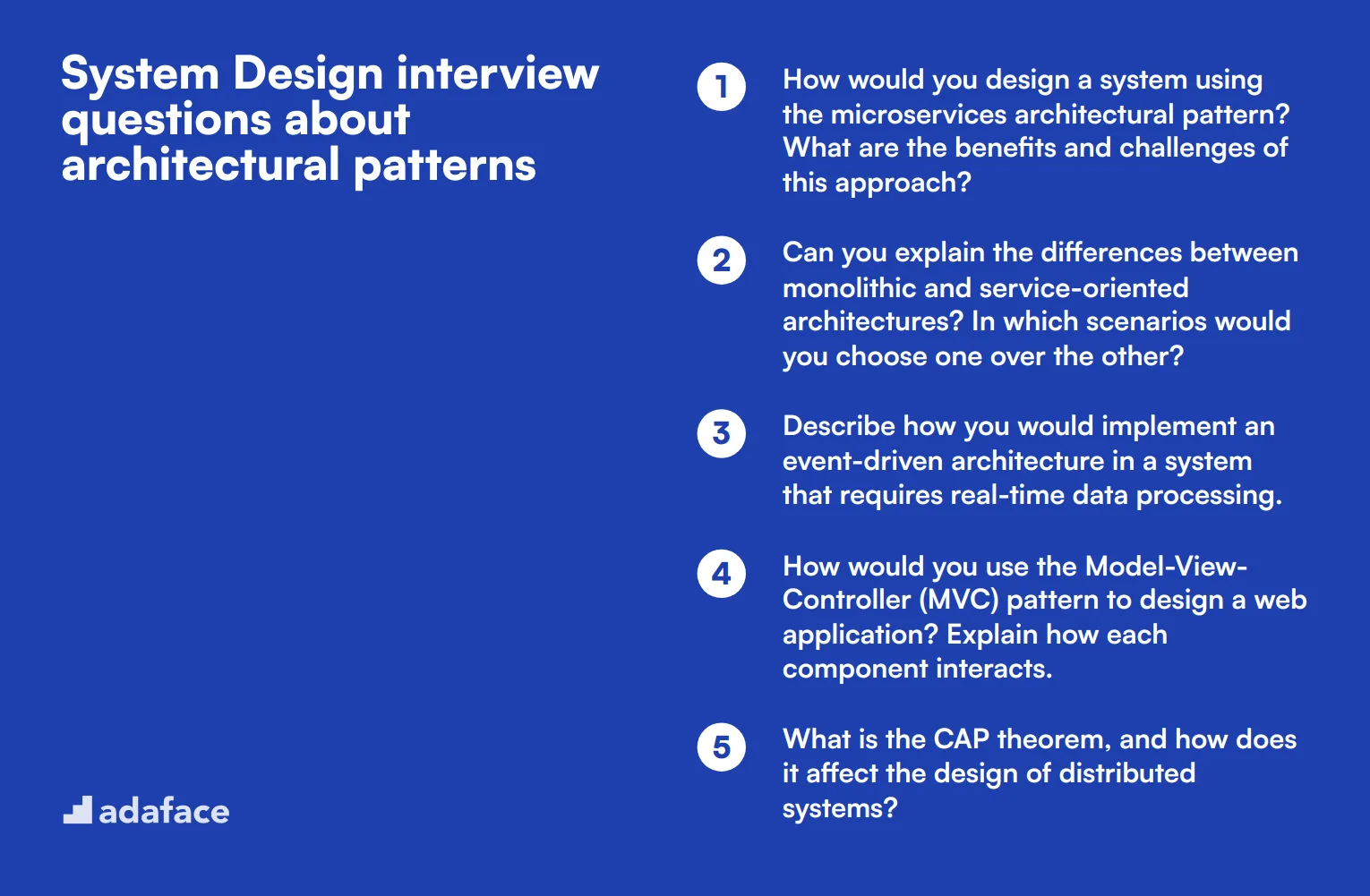
To effectively evaluate a candidate's understanding of architectural patterns, use these targeted questions in your interviews. These questions can help you determine if applicants have the right depth of knowledge and problem-solving skills for roles such as software architect.
- How would you design a system using the microservices architectural pattern? What are the benefits and challenges of this approach?
- Can you explain the differences between monolithic and service-oriented architectures? In which scenarios would you choose one over the other?
- Describe how you would implement an event-driven architecture in a system that requires real-time data processing.
- How would you use the Model-View-Controller (MVC) pattern to design a web application? Explain how each component interacts.
- What is the CAP theorem, and how does it affect the design of distributed systems?
- Explain how the CQRS (Command Query Responsibility Segregation) pattern can be used to handle complex business logic. What are the trade-offs?
- How would you design a system using the layered architecture pattern? What are the advantages and disadvantages of this approach?
- Describe a scenario where you would use the microkernel architecture. How does it enhance system flexibility?
- Can you explain how to implement the dependency injection pattern in a software system? What are its benefits?
- How would you design a system using the serverless architecture? What are the key considerations and limitations?
- Describe how you would use the repository pattern to manage data access in a large-scale application.
- How would you design a system using the hexagonal architecture (ports and adapters)? What problems does this pattern solve?
Which System Design skills should you evaluate during the interview phase?
While a single interview might not be sufficient to assess every aspect of a candidate's skills, focusing on key system design competencies can provide valuable insights into their capabilities. System design interviews should target the core skills essential for designing, managing, and scaling systems effectively.
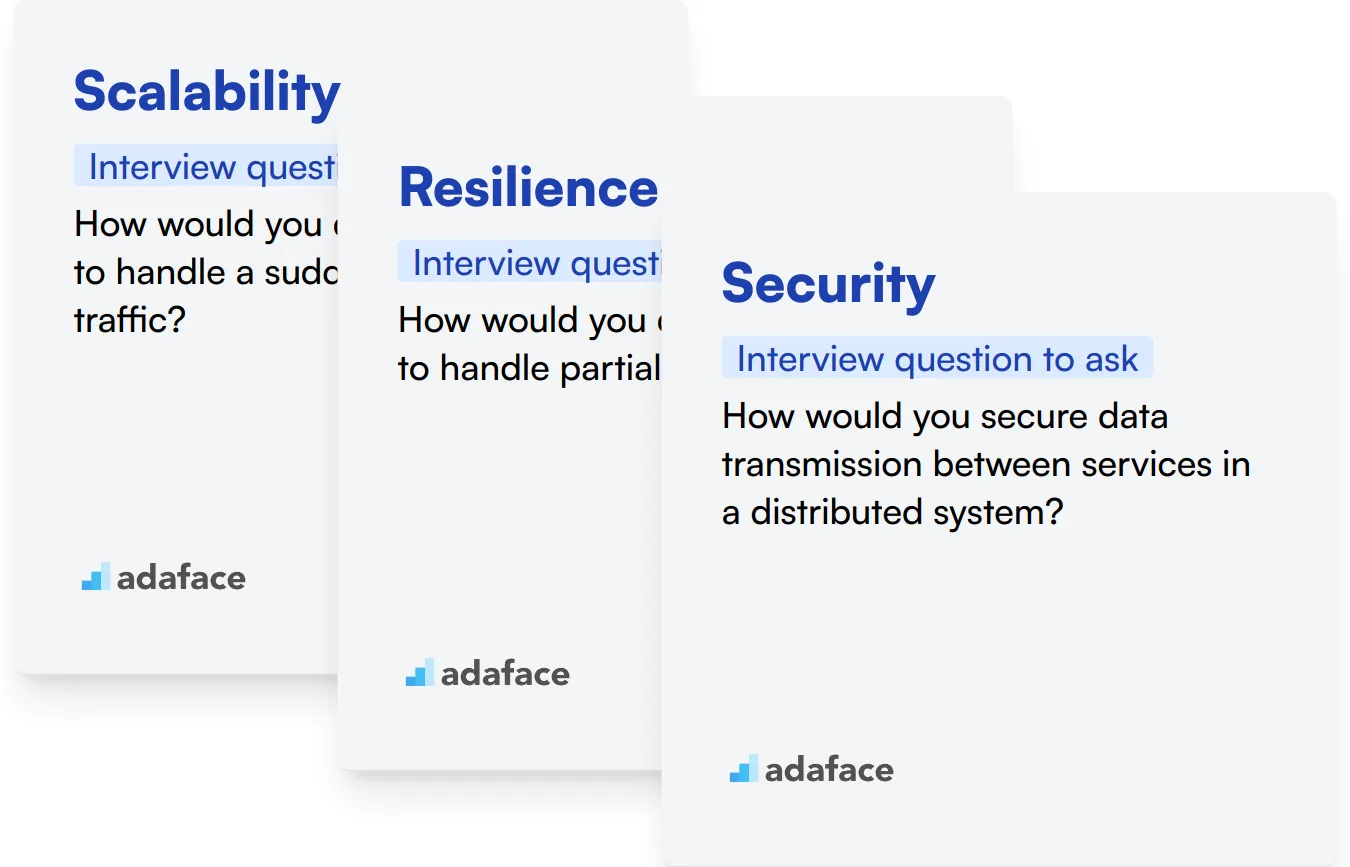
Scalability
Scalability is crucial in system design as it determines how well a system can handle growth. It ensures that a system can accommodate increased load without compromising performance, which is essential for maintaining a seamless user experience.
Consider using an assessment test that includes MCQs on scalability principles and best practices. Our System Design Online Test can help filter out candidates with strong scalability knowledge.
During the interview, try asking targeted questions to evaluate the candidate's understanding of scalability.
How would you design a system to handle a sudden spike in user traffic?
Look for answers that discuss strategies like load balancing, caching, and database sharding. Assess whether the candidate can offer practical solutions and has a good grasp of scalability concepts.
Resilience
Resilience in system design refers to a system's ability to recover from failures and continue operating smoothly. This skill ensures that the system can withstand and quickly recover from unexpected disruptions, which is critical for maintaining service availability.
Consider using an assessment test that evaluates resilience concepts and fault tolerance mechanisms. Our System Design Online Test includes relevant questions to assess this skill.
During the interview, ask questions that focus on a candidate's ability to design fault-tolerant systems.
How would you design a system to handle partial network failures?
Evaluate their understanding of strategies like redundancy, failover mechanisms, and distributed systems. Good candidates will discuss how to detect, isolate, and recover from failures efficiently.
Security
Security is a foundational aspect of system design, ensuring that data and services are protected against unauthorized access and attacks. A strong security design safeguards both the integrity and confidentiality of the system.
Using an assessment test with MCQs focused on security practices can help identify candidates with a solid understanding of system security. Our System Design Online Test includes questions on this topic.
Ask targeted questions to understand how well the candidate can integrate security into their system design.
How would you secure data transmission between services in a distributed system?
Look for answers that mention encryption methods, secure protocols, and authentication mechanisms. Candidates should demonstrate an understanding of common security threats and mitigation strategies.
Enhance Your Hiring Strategy with System Design Skills Tests and Targeted Interview Questions
When aiming to hire professionals with system design expertise, it's important to verify their skills effectively.
The most reliable way to assess these skills is through specialized tests. Consider utilizing the Software System Design Online Test from Adaface to gauge applicant capabilities accurately.
After administering the test, you can streamline the selection process and invite only the most qualified candidates for interviews, ensuring a high-quality shortlist.
To take the next step in your hiring process, sign up on our platform and explore various resources. Visit our sign-up page to create an account or learn more about our offerings on the online assessment platform page.
System Design Online Test
Download System Design interview questions template in multiple formats
System Design Interview Questions FAQs
Look for problem-solving abilities, knowledge of scalable architecture, experience with distributed systems, and communication skills.
Start with high-level requirements, then dive into specific components, scalability, data flow, and performance considerations.
Ask fundamental design questions and evaluate their understanding of basic concepts and their approach to problem-solving.
Common mistakes include not clarifying requirements, ignoring scalability, and failing to consider trade-offs and bottlenecks.
Evaluate the complexity of problems they can solve, their depth of knowledge in specific areas, and their ability to design scalable systems.
Architectural pattern questions help assess a candidate's understanding of best practices and their ability to apply these patterns effectively.

40 min skill tests.
No trick questions.
Accurate shortlisting.
We make it easy for you to find the best candidates in your pipeline with a 40 min skills test.
Try for freeRelated posts
Free resources




